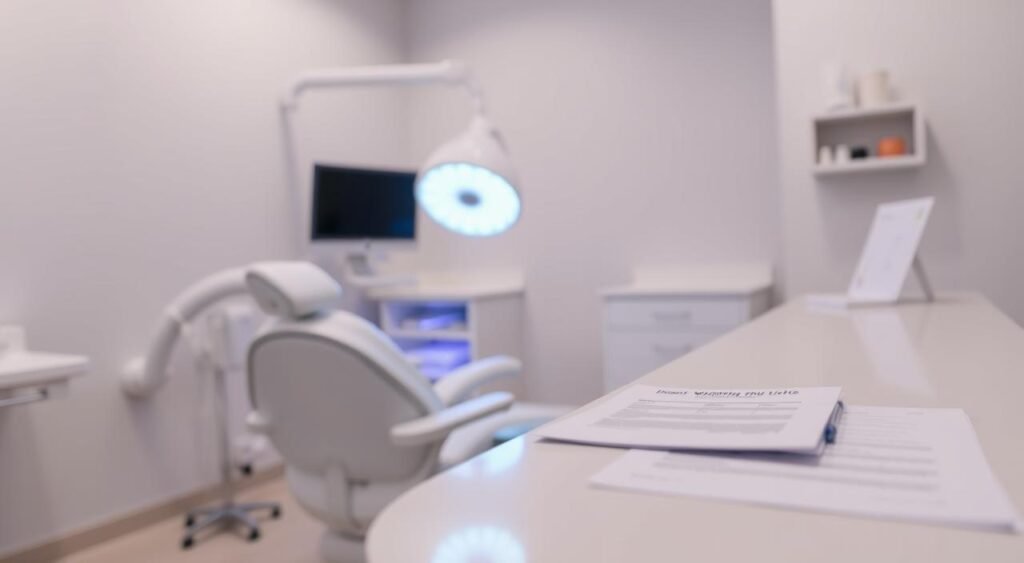Ever thought your shiny smile could be covered by dental insurance? Many wonder if dental plans pay for teeth whitening. The question “is teeth whitening covered by insurance?” is common, and it’s not just about looks—it’s about knowing what your insurance covers.
Teeth whitening is a common cosmetic treatment. But, dental insurance doesn’t always cover it. This is because it’s seen as a cosmetic, not a medical need.
Professional teeth whitening can cost a lot. It’s about $293 per arch, or $600 for both. Internal bleaching costs around $272 per tooth. These prices can quickly add up, making insurance coverage important for a brighter smile.
Even though rare, some plans might cover teeth whitening a bit. It’s key to check your policy or talk to your provider. Knowing what’s covered helps you plan your dental care and budget for cosmetic treatments.
Teeth Whitening Procedures
Teeth whitening options range from professional treatments to at-home solutions. Your choice depends on your budget and desired results. Let’s explore the different teeth whitening treatments available.
Professional In-Office Whitening
Professional teeth whitening at a dental office offers the most dramatic results. This procedure typically costs around $650 to $1,000. Dentists use high-concentration bleaching gels and special lights to achieve a brighter smile in just one visit.
At-Home Whitening Options
Dentist-provided take-home trays offer a middle ground. These custom-fitted trays cost about $400 and allow you to whiten your teeth at home. You’ll get professional-grade results without the high price of in-office treatments.
Over-the-Counter Products
For budget-friendly teeth whitening options, consider over-the-counter products. Whitening strips, toothpastes, and pens range from $20 to $100. While less powerful than professional treatments, these products can effectively remove surface stains.
- Whitening strips: Easy to use, stick directly to teeth
- Whitening toothpastes: Good for daily maintenance
- Whitening pens: Convenient for touch-ups
Remember, results vary based on the method you choose. Professional teeth whitening treatments often provide faster, more noticeable results compared to at-home options. Consider your budget and desired outcome when selecting the best teeth whitening option for you.
The Cost of Teeth Whitening Without Insurance
Teeth whitening costs can vary a lot. Professional in-office whitening is the most expensive. It can cost between $300 to $1,000 per treatment.
This high price is because of the dental expert’s skill and advanced methods used.
At-home whitening kits are cheaper. They cost between $100 and $600. These kits are less expensive but can give good results with a dentist’s help.
For those on a tight budget, there are cheaper options. Whitening strips and gels cost $10 to $55. Toothpastes are even cheaper, from $1 to $20. But, these might not work as well as professional treatments.
The price also depends on where you live and how bad your teeth are. Cities usually charge more than rural areas. Most insurance doesn’t cover teeth whitening because it’s seen as cosmetic. Always talk to your dentist to find the best and most affordable option for you.
Is Teeth Whitening Covered by Insurance?
Dental insurance plans usually don’t cover teeth whitening. They focus on essential dental care. Cosmetic procedures are often not covered.
Your dental insurance plan covers preventive services fully. It covers basic procedures at 80% and major treatments at 50%.
Typical Insurance Coverage for Dental Procedures
Insurance plans cover routine cleanings, fillings, and root canals. These are seen as necessary for oral health. Teeth whitening, considered cosmetic, is often not covered.
Exceptions to Standard Coverage
Some dental plans offer limited coverage for teeth whitening. For example:
- Ameritas PrimeStar Access: 20% reimbursement for in-network whitening
- Anthem’s Essential Choice PPO Platinum: 50% coverage after 3 months
- Guardian Direct Diamond: 50% coverage after 6 months
Dental Plans That May Cover Teeth Whitening
Some insurance plans might cover 20-50% of in-office whitening costs. In-office whitening could cost $350 to $700 with insurance. Dentist-provided whitening kits might cost $210 to $350 with coverage.
Without insurance, expect to pay $500 to $1,000 for in-office sessions.
Check your plan details or contact your provider to understand your specific coverage. Remember, even if covered by dental insurance, waiting periods and coverage limits may apply.

When Teeth Whitening Might Be Covered
Dental insurance rarely covers teeth whitening. But, there are some exceptions. Let’s look at when your insurance might pay for this cosmetic treatment.
Insurance might cover teeth whitening if it’s medically needed. This includes discoloration from health issues or medication side effects. Also, if tooth discoloration comes from trauma or injury, you might get coverage.
Some employer plans offer cosmetic coverage. This might include teeth whitening. Check your plan or ask HR about this benefit.
- Discoloration from medical conditions
- Tooth staining from medication
- Optional cosmetic coverage in some plans
To get insurance to cover teeth whitening, you need proof. Get documents from your dentist or doctor explaining why you need it. This proof is important for insurance approval.
Most dental plans don’t cover cosmetic treatments. The coverage for teeth whitening is usually 20-50%. In-office treatments with insurance cost $350-$700 per session. Without insurance, it’s $500-$1,000.
Alternatives to Insurance Coverage for Teeth Whitening
If your insurance doesn’t cover teeth whitening, don’t worry. There are many ways to make it more affordable. Let’s look at some options to help you get a brighter smile without spending too much.
Dental Discount Plans
Dental discount plans give you lower fees for dental services, including teeth whitening. You pay a yearly fee for membership. This can make teeth whitening services much cheaper.
Financing Options
Many dental offices have financing plans for cosmetic procedures like teeth whitening. These plans let you pay over time, fitting it into your budget. Some clinics work with financing companies for low-interest or no-interest options.
Saving Strategies for Cosmetic Dental Procedures
Here are some ways to save on teeth whitening:
- Look for promotional offers from local dentists
- Consider at-home whitening kits for a more budget-friendly option
- Ask about package deals that combine teeth whitening with other dental services
- Inquire about student discounts at dental schools that offer cosmetic procedures
Remember, while looking for affordable options, always choose quality and safety. Talk to a dental professional to find the best way for your smile and budget.
The Long-Term Value of Teeth Whitening
Teeth whitening treatments can last a long time. Professional whitening can make your smile bright for about a year. This makes the cost worth it for a long, shining smile.
Custom whitening trays from dentists can keep your smile bright for six months to a year. They mix professional care with easy at-home use. Whitening strips can also brighten your teeth for about six months.
For those on a budget, whitening toothpaste can brighten teeth for three to four months. Whitening pens give a quick fix, lasting up to a week. But, things like coffee or smoking can affect how long your teeth stay white.
Some stains might need more than one treatment. Whitening costs vary, from $20 for home products to $650 for professional treatments. Insurance might not cover it, but some plans help with in-network costs.
Teeth whitening is more than just looks. It boosts confidence and makes a good first impression. For many, it’s a smart investment.
How to Approach Your Dental Insurance Provider
Talking to your dental insurance about teeth whitening can be hard. It’s important to know how to ask about this treatment.
Questions to Ask About Coverage
When you call your insurance, ask specific questions. Find out if they cover teeth whitening. Here are some important questions:
- Does my plan cover any form of teeth whitening?
- Are there any circumstances where teeth whitening might be covered?
- What documentation do I need to provide for coverage?
Documenting Medical Necessity
Teeth whitening might be needed for health reasons. Work with your dentist to get the right papers. You might need:
- Dental records showing the need for treatment
- Photos of your teeth
- A letter from your dentist explaining why the procedure is needed
Appealing Coverage Decisions
If your insurance denies teeth whitening, you can appeal. Get evidence from your dentist. Write a clear letter explaining why you think it should be covered. Remember, being persistent can help with insurance companies.
Conclusion
Teeth whitening options can be tricky, thanks to dental insurance. Most plans don’t cover it, but some offer a little. Without insurance, costs range from $50 for home kits to $1,800 for professional treatments.
If insurance doesn’t cover it, don’t fret. You have other ways to get a whiter smile. You can try over-the-counter products, dental discount plans, or financing. A brighter smile might be worth the cost in the long run.
Think about your budget, what you want, and your teeth’s health before choosing. Talk to your dentist to find the best choice for you. Whether it’s professional treatments or home kits, knowing your options helps you get the smile you dream of.
FAQ – Teeth Whitening Costs and Insurance
What is the typical cost of professional in-office teeth whitening?
Professional teeth whitening costs about $600 for full treatment. On average, it’s $293 per arch.
Do most dental insurance plans cover teeth whitening?
Most dental insurance plans don’t cover teeth whitening. It’s seen as a cosmetic procedure. However, some plans might offer limited coverage with different rates and waiting times.
What are some exceptions when teeth whitening might be covered by insurance?
Insurance might cover teeth whitening in certain cases, such as if it’s medically necessary due to a condition or medication side effects, after trauma or injury causing discoloration, or in some employer plans offering cosmetic coverage. You’ll need to show medical need for coverage.
What are some at-home teeth whitening options and their costs?
At-home options include custom trays from dentists for about $243 per arch. Over-the-counter strips are cheaper but less effective. Whitening toothpastes and pens can help remove surface stains.
How long do teeth whitening results typically last?
In-office whitening lasts about a year. Custom trays can keep results for six months to a year, strips last six months, and toothpastes and pens last three to four months with regular use. Lifestyle choices can shorten results.
What alternatives are available for teeth whitening without insurance coverage?
Without insurance, you can try dental discount plans for lower fees, financing or payment plans from dentists, over-the-counter products, or home remedies. Dental schools might offer cheaper services, and you could negotiate with dentists for discounts or look into savings plans for whitening.
What should you ask your dental insurance provider about teeth whitening coverage?
First, review your policy documents, then contact customer service to ask about coverage. Inquire about exceptions or when coverage might apply. For medical cases, get your dentist to provide the necessary documentation. If coverage is denied, ask about appeals and gather supporting evidence.









2 Comments
Pingback: Should I Brush My Teeth Before Using Whitening Strips?
Pingback: How Long Does Teeth Whitening Last? Essential Guide